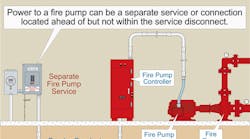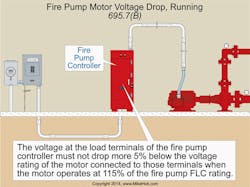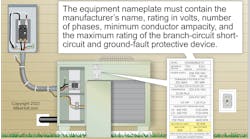In the NEC, the normal philosophy for circuit protection is to shut down equipment before allowing the supply conductors to overheat. Article 695 departs from this philosophy. The fire pump motor must run no matter what. The pump supplies water to a facility’s fire protection piping, which supplies water to the sprinkler system and fire hoses.
Article 695 contains many requirements to ensure an uninterrupted supply of water. Some of these requirements seem wrong at first glance, until you remember why that fire pump is there in the first place.
Scope
Article 695 covers the installation of electric power sources and interconnecting circuits. It also covers switching and control equipment dedicated to fire pump drivers [695.1].
Article 695 doesn’t cover:
• Performance, maintenance, testing, or internal wiring of the system components.
• Installation of pressure maintenance (jockey or makeup) pumps; Article 430 governs that, whether or not the fire pump supplies these pumps.
• Transfer equipment upstream of the fire pump transfer switch(es).
Power sources for electric motor-driven fire pumps
A fire pump motor must be supplied by a reliable source of power that can carry the locked-rotor current of the fire pump motor(s) and pressure maintenance pump motor(s). The source must also be able to carry the full-load current of any associated fire pump equipment [695.3(A)].
Permitted reliable sources of power include:
• Separate service.
• Service or dedicated feeder connection located ahead of (not within) the service disconnecting means (Fig. 1).
• On-site power supply (e.g., generator), located and protected to minimize damage by fire.
If reliable power can’t be obtained from a source described in Sec. 695.3(A), power must be supplied by one of the following:
• Individual sources. A combination of two or more sources from Sec. 695.3(A) approved by the authority having jurisdiction (AHJ) [695.3(B)(1)].
• Individual source and on-site standby generator. A combination of one of the sources in Sec. 695.3(A) and an on-site standby generator complying with Sec. 695.3(D) — approved by the AHJ [695.3(B)(2)].
But there’s an Exception to Sec. 695.3(B)(1) and (B)(2). It states that an alternate source of power isn’t required where a back-up engine-driven or back-up steam turbine-driven fire pump is installed.
Transfer of power to the fire pump controller must take place within the pump room. A listed fire pump transfer switch must select the source of supply. You can’t use phase converters for fire pump service [695.3(F)].
Related
Power continuity
Circuits that supply electric motor-driven fire pumps must be supervised from inadvertent disconnection as follows [695.4(A) or (B)].
(A) Direct connection. The supply conductors must directly connect the power source to a listed fire pump controller, listed fire pump transfer switch, or listed combination fire pump controller and power transfer switch.
(B)(1)(a) Connection through disconnecting means and overcurrent device (OCPD). A single disconnecting means and associated OCPD(s) are permitted between the fire pump power source(s) and one of the following:
1) Listed fire pump controller.
2) Listed fire pump power transfer switch.
3) Listed combination fire pump controller and power transfer switch.
Overcurrent protection for individual sources must comply with Sec. 695.4(B)(2)(a)(1) or (2):
(1) Individual sources. The OCPD(s) must be selected or set to carry indefinitely the sum of the locked-rotor current of the largest fire pump motor and pressure maintenance pump motor(s), plus 100% of the full-load current of the other pump motors and fire pump accessory equipment.
If the locked-rotor current value doesn’t correspond to a standard OCPD size, use the next standard OCPD size per Sec. 240.6. The requirement to carry the locked-rotor current indefinitely doesn’t apply to fire pump motor conductors.
(2) Assemblies. Overcurrent protection must be provided by an assembly listed for fire pump use. The OCPD must not open:
• Within 2 min. at 600% of the full-load current of the fire pump motor(s).
• With a restart transient of 24 times the full-load current of the fire pump motor(s).
• Within 10 min. at 300% of the full-load current of the fire pump motor(s).
Also, the trip point for the circuit breaker must not be field adjustable.
The disconnecting means for the normal power source must be [695.4(B)(3)(a)]:
• Identified as suitable for use as service equipment.
• Lockable in the closed position, with the provision for locking remaining in place with or without the lock installed.
• Not located within the same enclosure, panelboard, switchboard, switchgear, or motor control center (with or without a common bus) that supplies loads other than the fire pump.
• Located sufficiently remote from other building or other fire pump source disconnecting means such that inadvertent operation at the same time would be unlikely.
When an on-site generator is the alternate power source, its disconnecting means must be installed per Sec. 700.10(B)(5) for emergency circuits. It must also be capable of being locked in the closed (ON) position; the provision for locking must remain in place with or without the lock installed [695.4(B)(3)(b)].
The disconnecting means must be marked “Fire Pump Disconnecting Means.” The letters must be at least 1 in. tall and visible without opening enclosure doors or covers [695.4(B)(3)(c)].
Transformers
If a transformer supplies an electric fire pump motor, size it at least 125% of the sum of the fire pump motor(s) and pressure maintenance pump(s) motor loads, plus 100% of the ampere rating of the fire pump’s accessory equipment [695.5(A)].
Size the primary OCPD to carry indefinitely the sum of the locked-rotor current of the fire pump motor(s) and pressure maintenance pump motor(s), plus 100% of the ampere rating of the fire pump accessory equipment. Secondary overcurrent protection isn’t permitted. The requirement to carry the locked-rotor currents indefinitely doesn’t apply to fire pump motor conductors [695.5(B)].
Wiring
Service conductors and conductors supplied by on-site power production facilities must be physically routed outside buildings and installed as service-entrance conductors per Art. 230. If supply conductors can’t be routed outside of buildings, they can be encased in 2 in. of concrete or brick (if beneath a building) or in a raceway that’s encased in 2 in. of concrete or brick (if within a building) [230.6(1) or (2)][695.6(A)(1)].
Fire pump supply conductors must [695.6(A)(2)]:
• Be kept entirely independent of all other wiring.
• Supply only loads directly associated with the fire pump system.
• Be protected from potential damage by fire, structural failure, or operational accident.
When fire pump conductors are routed through a building, ensure they are one of the following [695.6(A)(2)(d)]:
• Encased in a minimum 2 in. of concrete.
• Within an enclosed construction dedicated to the fire pump circuit(s) and having a minimum of a 2-hr fire-resistive rating.
• A listed electrical circuit protective system with a minimum 2-hr fire rating.
All wiring from the fire pump controllers to the fire pump motors must be in rigid metal conduit, intermediate metal conduit, electrical metallic tubing, liquidtight flexible metal conduit, liquidtight flexible nonmetallic conduit Type LFNC-B, listed Type MC cable with an impervious covering, or Type MI cable.
The connections in the motor terminal box must be made with a listed device. Twist-on, insulation-piercing type and soldered wire connectors aren’t allowed [695.6(D)]. Ground-fault protection of equipment isn’t permitted for fire pumps [695.6(G)].
All control wiring must be in rigid metal conduit, intermediate metal conduit, liquidtight flexible metal conduit, liquidtight flexible nonmetallic conduit Type B (LFNC-B), listed Type MC cable with an impervious covering, or Type MI cable [695.14(E)].
Conductor size
Conductors supplying a fire pump motor, pressure maintenance pump, and associated fire pump accessory equipment must have a minimum ampacity of at least 125% of the sum of the fire pump motor(s) and pressure maintenance motor(s) full-load current(s), and 100% of the associated fire pump accessory equipment [695.6(B)(1)].
Conductors supplying only a fire pump motor must have a minimum ampacity of at least 125% of the motor full-load current rating per Sec. 430.22 and must comply with the voltage drop requirements in Sec. 695.7 [695.6(B)(2)] (Fig. 2).
Voltage drop
Starting. When the motor starts (locked-rotor current), the voltage at the line terminals of the fire pump controller must not drop more than 15% below the controller’s rated voltage [695.7(A)].
Running. Voltage at the load terminals of the fire pump controller must not drop more than 5% below the voltage rating of the motor connected to those terminals when the motor operates at 115% of the fire pump motor full-load current rating [695.7(B)], as shown in Fig. 3.
Avoiding confusion
Remember, the fire pump must be kept in service even if doing so destroys the motor. It’s better to run the pump until its motor windings melt than to save the motor and lose the facility. The intent of this Article is to allow enough time for building occupants to escape and, if possible, for the fire pump to help save the facility.
These materials are provided to us by Mike Holt Enterprises in Leesburg, Fla. To view Code training materials offered by this company, visit www.mikeholt.com/code








